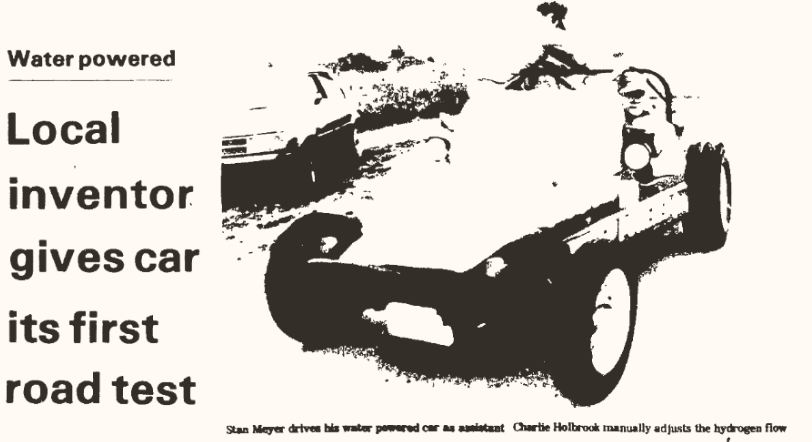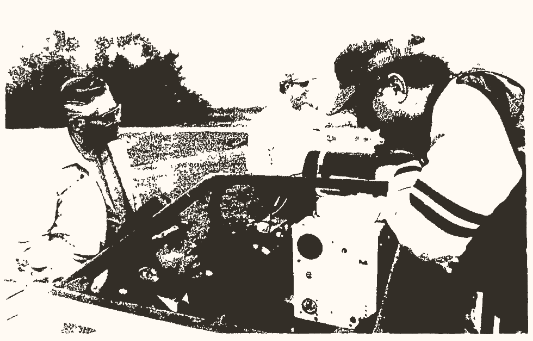Local inventor gives car its first road test - October 17th, 1985
By Shannon Hanscom
October 17th, 1985
Source: https://grovecity.advantage-preservation.com/viewer/?k=&t=30203&i=t&d=01011901-12312011&m=between&ord=k1&fn=the_grove_city_record_usa_ohio_grove_city_19851017_english_5&df=21&dt=30
 According to local inventor Stan Meyer, he had been waiting 10 years for what happened last Friday. That is when he drove his water-powered car, powered by the Water Fuel Cell, in a road test for the first time.
According to local inventor Stan Meyer, he had been waiting 10 years for what happened last Friday. That is when he drove his water-powered car, powered by the Water Fuel Cell, in a road test for the first time.
Among the witnesses were the Grove City Record; several friends and relatives of Meyer; Jack Cook of Jack’s VW Service; and Lt. Col. Stanley Parkinson of the United States Air Force.
To everyone’s astonishment, Meyer drove his Water Fuel Cell-powered dune buggy several times at distances covering nearly one mile, at speeds in excess of 50 MPH. The demonstration came nearly one year after Meyer presented the car in an idling condition for the Record.
Meyer said since those tests a year ago, he has been working on the acceleration controls and the method by which to accurately control the burn rate of the hydrogen gas. Although the system is not perfected, he said he is planning a demonstration for the national press within the next several weeks.
“Up until recently, we had the car idling on the Water Fuel Cell sitting on the ground and ran static testing,” Meyer said. “Then, we began working on the accelerator controls to learn how to mix the hydrogen gas, exhaust gas, and ambient air, for actual road testing under load conditions. That had to be done before the car could be driven. It is one thing to operate the car under lab conditions, and another to drive it on the road under load conditions,” Meyer added.
Air Force to examine
According to Lt. Col. Parkinson, he said there is no doubt that, “the system in the fuel cell is breaking down water in component parts via the Water Fuel Cell and operating the dune buggy.”
Parkinson has degrees in industrial and systems engineering and is a 25-year Air Force veteran. He has spent the last 15 years as an Air Force program manager and systems engineer in research and development of most and application of weapons systems.
“Technically, from my viewpoint, there is no doubt that the system can quickly break down water into hydrogen and oxygen. It is working. But to perfect it to a working system, we need more time and study,” Parkinson said.
“It will still take some time to work out the controls. I can’t tell how long that will be. It may be right around the corner. He may have a few more hills to climb, but it appears they may be climbed. Now he has to work out further control of the burn mixture of the gases, and he will have a real system.”
After a break, the gas tank was removed from the car, the hydrogen gas valve was opened, and the Water Fuel Cell was started and gas production began again. Meyer then drove the car, with assistant Charlie Holbrook manually adjusting the hydrogen flow.
Lt. Col. Parkinson was then given a ride of more than a half-mile at 21 MPH. Cook was given a ride of about 7 miles at speeds in excess of 50 MPH. The Record reporter then rode almost twice at about 7 miles between 45-55 MPH. Finally, Meyer drove the car almost at full mile at 50 MPH with Holbrook and another friend.
Although Meyer was excited by the performance of the car, the demonstration highlighted some areas that need improvement. He operated the car up grades with more than 940 pounds of passengers and equipment payload. The car accelerated well, but each time the dune buggy maneuvered around several small curves, Holbrook had difficulty maintaining constant hydrogen flow. When Meyer had to slow down, the hydrogen flow remained the same, thus flooding out the engine.
Also, before each test run, the car had to be started with gasoline, then switched to the hydrogen gas.
Inventor operates water car
Meyer said those problems would be solved as soon as he perfects the injection system for the car.
“When the injection system is perfected, we can start on hydrogen, and then run the car longer than we can on gasoline.”
Accomplishments
He knows he has work to do, but Meyer said he is pleased with last Friday’s road tests. He said several major events took place that were impossible up until then.
Before Friday, no one had efficiently burned hydrogen in an automobile without building a special engine, or mixing the hydrogen with water or gasoline. That results in most of the hydrogen being lost out of the tailpipe, Meyer said.
Also, no one had previously built a hydrogen device that could easily retrofit to an existing automobile without major changes.
And, no one previously had the answers of how to produce the hydrogen on demand, and adjust the burn rate of the hydrogen down to the burn rate of fossil fuels. The inventor said last week’s test served three purposes. He said he wanted to disconnect the umbilical cord of the lab unit from the car, observe performance under load conditions and acceleration, and have a self-sustained operation under low hydrogen gas backpressure of 12 to 14 pounds. He said all three were achieved.
While driving the car, he varied the rate of hydrogen gas generation from plain water by simply varying the field of a pulsing voltage frequency generator: “restricting the amperes for operation of the generator, I varied from one to two to 10 amperes for operation of the alternator in the lab unit,” Meyer said. “I varied the energy field from 1 volt to 110 volts to help demonstrate control over the volume of hydrogen generation under load conditions.”
Local mechanic Jack Cook (left), Lt. Col Edward Parkinson (center), and inventor Stan Meyer discuss the operation of the water-powered car during test runs last Friday. Meyer said he will demonstrate the car before the national press within the next few weeks.
He said the gas production was instantaneous when he increased the voltage, the pressure of the gas was maintained while the flow rate to the engine increased, and response of the engine was instantaneous, equaling or surpassing the use of gasoline.
Mechanic impressed
Meyer said local mechanic Jack Cook said he couldn’t believe it when the dune buggy started, ran, and stopped without gasoline.
“I looked the car over very carefully. There is no way the car could have been running on anything but hydrogen produced in the fuel cell. The only thing he has to do now is perfect the hydrogen injectors. He wanted to prove he could run the car on water, and he did it. I think he knows what he has to do. I have been a mechanic for 40 years and that is the most remarkable thing I have seen,” Cook said.
Now what?
Meyer points out that hydrogen is a more powerful fuel than gasoline. A car that gets 15 MPG on gasoline could go 45 MPG on a gallon of hydrogen, he said. Meyer said the car fuel cell produces hydrogen on demand. There is no storage of hydrogen, just water. Meyer said that surpasses all existing Federal safety regulations.
Emissions amount to water vapor, and water contaminants may be removed by a throw-away filter that should please the EPA. He said the EPA had not received back into the system, the water vapor would naturally be recycled back into the atmosphere.
Meyer points out that the Water Fuel Cell injector is still under construction.
“This is one of the first fuel injection systems for hydrogen which will match the burn rate of hydrogen to gasoline under road test conditions.”

